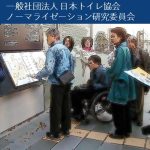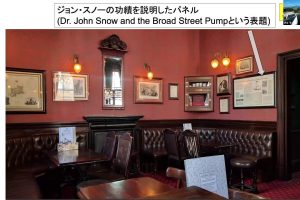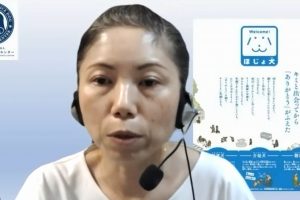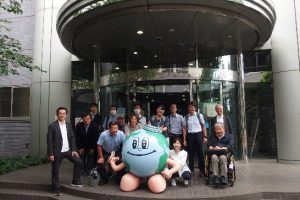Date: 31 August 2023 (Thu) 18:00-20:00 JST
- Master of Ceremony (MC)
- Mikiko Takahashi,Ph.D. Director of JTA, Manager of R&D Division of Comany Inc.
- Presenters
- Airport toilets that everyone loves: Renovating toilets at Narita International Airport
Mr. Hiroaki Abe, Mr. Takako Okamoto, and Ms. Kuniko Hamaka, Space Design Co., Ltd. - Exploring the sound environment required for the toilets in the school facilities
Ms. Erina Yaguchi, 2nd year student in the Graduate School of Design at Okayama Prefectural University - Evaluating a cleaning request button to keep toilets clean
Ms. Arisaka Sekiya, Central Nippon Expressway Co., Ltd. - A supermarket project that is easy even the dementia: A unisex toilet for the dementia users
Mr. Akihiro Tsujino, Maiya Co., Ltd.
- Airport toilets that everyone loves: Renovating toilets at Narita International Airport
Opening address
(Asai) I am a leading secretary of the JTA Toilet Award Committee at Japan Toilet Association (JTA). JTA was founded in 1985 to make the public toilets clean. We started this award with the hope that by focusing the clean and comfortable public toilets through Japan. Initially, we named it the “Good Toilet 10,” and each year we selected ten good toilets and awarded them.
This continued for about 15 years with a total of about 1,000 applications. After that, we changed the name to “Good Toilet Award”, and expanded the awarding scope not only the buildings themselves but also the activities and maintenance. As toilet related activities have expanded to various fields, we modified into four category awards in 2021. Due to this background, we renamed “JTA Toilet Award.”
(Takahashi) Today, we are delighted to hear from the presenters who were selected JTA Toilet Award in 2022.
1. Airport toilets for everyone loves: Renovating toilets at Narita International Airport

(Abe) My name is Abe and CEO of Space Design Co., Ltd. Our company is an architectural design office that was established in 1996 with about 28 staffs. We work by the flextime systems and teleworking. This design office is assigned as an excellent health management by the Ministry of Economy, Trade and Industry. Our efforts are being made to build buildings with high resilience performance, since Japan is prone to natural disasters.
(Okamoto) There are totally 146 toilets at Narita International Airport (NRT) that are undergoing renovation work in order. Five among them have been completely finished. When renovating them, the concepts were “Snow, Moon, and Flowers” which have long been representative of the beauties in Japan with the spiritual landscape with its four seasons.
The toilets at the arrivals lobby in the airport have Flower patterns to heighten the sense of the excitement at the start of the journey for the visitors to Japan.
The toilets at the departure lobby have Moon pattern to evoke the image of a quiet night as the end of the journey for those visitors.
The toilets in the departure concourse have Snow pattern, as the nostalgic memories of just last time in Japan before boarding.
There are spacious powder rooms. The diaper changing stand and other facilities have also been set for both men and women toilets.
The toilets are designed so that all spaces can be widely visible with concerning to the crime prevention and alleviating congestion.
It was just before 2020 Tokyo Olympic and Paralympic Games, we followed Tokyo 2020 Accessibility Guidelines which were in accordance with the guidelines set out by the International Paralympic Committee. For instance, the toilet cubicles were designed large enough to accommodate users with suitcases, strollers, and wheelchairs. For Snow themed toilets, the client requested that they must be brightly lit. Considering the uniform brightness overall, the indirect lighting method was applied for the softly lit atmosphere.
The hand washing basins and powder corner are designed with the various heights so that users can choose it depending on their height or size of their hand carrying bags.
The bottom of the hand washing basin at Moon theme toilet was designed to keep the space for the legs and knees of the wheelchairs.
The signs on the floor indicate where the users shall line up by separating from the flow line of the hand washing basin.
The ceiling lighting is designed with the impression of the moon floating in the sky.
The cubicles in the women’s toilet of Flower theme were arranged in a circle style.
The door colours can be changed whether it is open or closed to make it easier to recognize which cubicle is vacant to use.
(Hamaka) All gender toilet has been newly set in Flower theme toilets at the arrival lobby. As a new initiative at Narita Airport, this toilet has been set in addition to the multi-function toilets. This toilet cubicle is large enough occupancy for two adults to use and is located near the entrance for the crime prevention.
We held interviews with people from the Japan Developmental Disability Network at the
There was a concern that a person with the developmental disability might open the door and go out while the caregiver was using the toilet. The cubicle was located deep part of the entrance and made a waiting space for the care-receiver inner part of the cubicle. The patterned tiles were used on the walls of the waiting space. Then the care-receiver will look at them while waiting by refraining from the strange behavior.
There are two locks at the door placed one at the high position and the other at the low position, so that it cannot be opened instantly. This all-gender toilet is located in the most conspicuous place at the front of the toilet space, and the sign is posted informing all gender toilet.
There are two cubicles of the multi-purpose room, one for the right-handed users and the other is for the left-handed. They are layouted symmetrically. One of them has an ostomate waste sink. A large bed has been set in each room, so that they can be used in different ways.
There is enough turning space, 1.5 meters diameter to accommodate the wheelchairs even when the large bed is unfolded.
As they are the airport toilet, the cubicles for the large carts are set up in both the men’s and women’s toilet. The standard cubicles are also wide enough for the wheelchair access, and are equipped with a hand washing basin in the cubicle, a diaper-changing bed, a waste sink for the ostomates, and a changing clothes stand.
There is also a baby chair next to the urinals.
[Q & A]
(Q1: HO) What are the unique designs of the airport toilets?
(A1-1: Okamoto) The luggage carts often bump into the walls, so the materials used in the waist-high walls needed to be hard and robust. The steel materials were often used in the cubicles for the large carts. They also bump lower part of the wall, so the baseboards must be higher to guard.
(A1-2: Hamaka) The placement of the handrails, paper roll, and operation buttons on the walls has been standardized for the visual impairments.
The guide signs keep a contrast in brightness against the background wall.
To support the multilingual requirements, the four languages audio guidance has been set at the entrance to the toilets.
The guide signs are also written in four languages.
(C2: KA) The hand washing basin is set in the centre of the toilet so that users can use it in the in Snow theme toilets. However, it is very difficult for the visually impaired people to find it. Some hand washing basins are not embedded into the counter but placed on top of it. They are difficult to use by the wheelchair users, because there is no part to support their body.
(A2: Hamaka) This problem was also pointed at the planning process. The reason we placed the hand washing basin in the centre of the toilet was because it allows a full view of the room from the entrance, and we prioritized a more stylish view. For people who find it difficult to use it, we set one hand washing basin aside the wall easy to support their body.
2. Exploring the sound environment required for the toilets in the school facilities
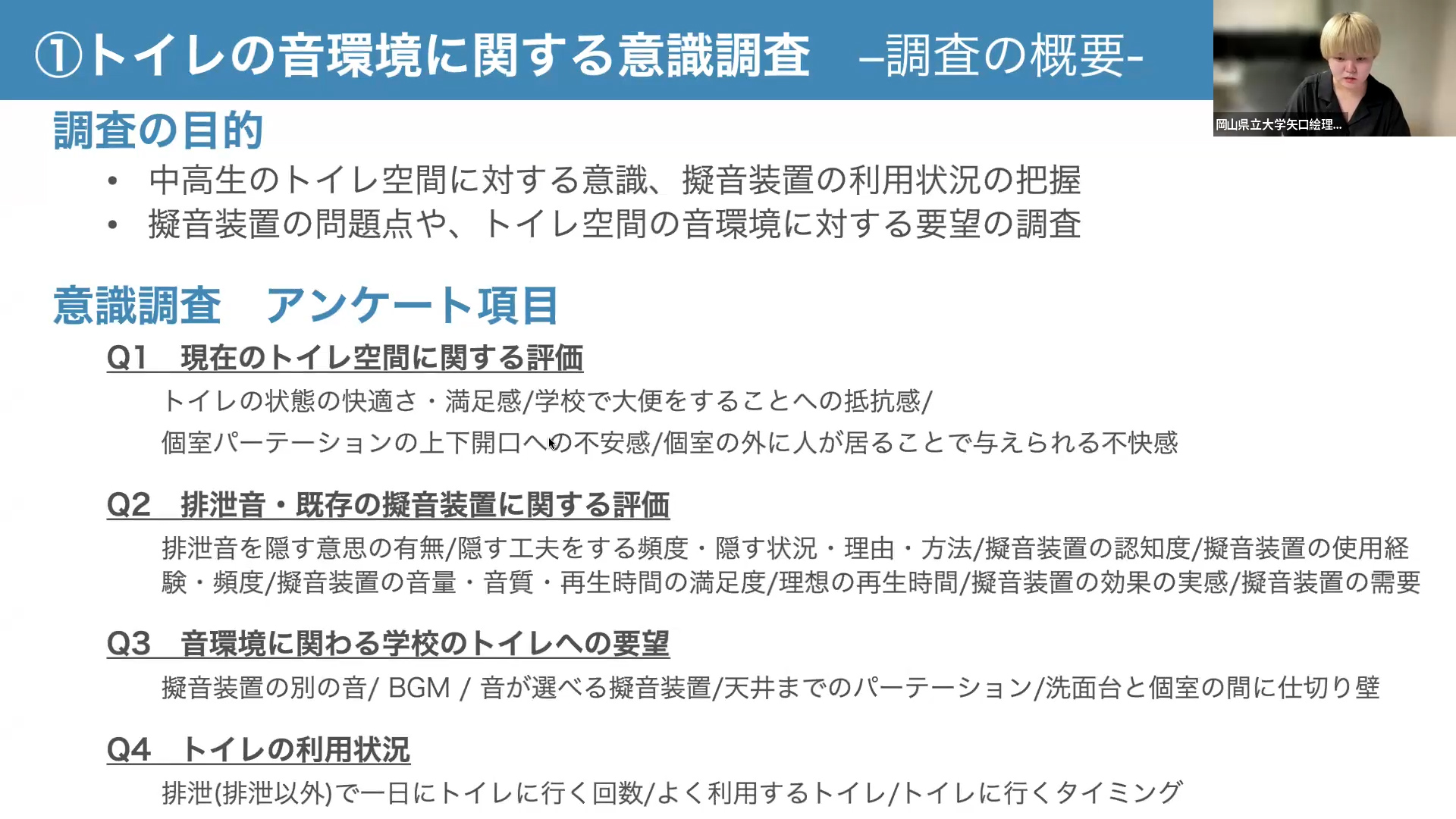 (Yaguchi) I am Ms. Yaguchi from Graduate School of Design at Okayama Prefectural University. The surveys of the elementary to the high school students have revealed that many students refrain from using the toilet at the school, because they do not want others to know or they feel uneasy to use it. The former research has shown that about 60% of the students were concerned about the excremental noise when using an outside toilet of the home. Many of those who are concerned this matter tried the flushing water or the noise masking devices to hide their noise. The devices are set in many commercial facilities, but many schools still do not, and there are no guidelines for the setting.
(Yaguchi) I am Ms. Yaguchi from Graduate School of Design at Okayama Prefectural University. The surveys of the elementary to the high school students have revealed that many students refrain from using the toilet at the school, because they do not want others to know or they feel uneasy to use it. The former research has shown that about 60% of the students were concerned about the excremental noise when using an outside toilet of the home. Many of those who are concerned this matter tried the flushing water or the noise masking devices to hide their noise. The devices are set in many commercial facilities, but many schools still do not, and there are no guidelines for the setting.
We conducted the survey at a junior and senior high school in Kagawa Prefecture in Japan, targeting all 557 students in 2021 and 521 students in 2022. A similar survey was also conducted this year for the students living in the student dormitory of this school. They presumably keep with a tight intimacy.
When it came to do defecating in school toilets, 78% of females and 52% of males, totaling 60%, responded that they felt awkward. It can be presumed that many students held their bowels in at school. The percentage of those who wanted to hide their excretion noises was high for both genders, with 92% of females and 58% of males.
A similar survey was also conducted in the student dormitory, and the percentage of students who wanted to hide their excretion noises was 81% of females and 50% of males. Even when relationships of the dormitory students must be more limited and intimate, the level of the awkward about the excretion noises was about the same as in the survey in the school toilet.
Additionally, the dormitory students were asked which toilets they felt easier to use either the dormitory toilets or the school ones. Many female students replied that they felt the school toilets easier to use because they were clean and there were noise masking devices. It was found that male students tend to find it easier to use the dormitory toilets by the close relationships. They are conscious of their surroundings and are reluctant to use the school toilet.
The noise masking device was known by nearly 100% female students in all grades, and over 90% had tried to use them. The male students’ knowledge of the devices tended to increase the higher the grade, but even though third-year high school students it was only 85%. Furthermore, only about 20% had tried to use them. Consequently, there was a large gap between male and female students.
Then next, the acoustic measurements were taken in the toilet. The noise level generated in the toilet was measured and the amount of the attenuation at each point was clarified. As a result, it was found that there were differences in the volume of the toilet flushing noise masking devices within the cubicles.
It was also found that the noise could be heard at the corridor.
There were opinions in the free-form comment about evening study period. There were not only the toilet flushing noise masking device but also the noises of the footsteps which leaked outside from the toilet. It must be necessary to improve the sound proofing for the toilet partitions.
In the provisional noise masking device experiment, three noise sources of the different frequency could be selected and we compared. The noise sources were set the peaks of 200 Hz for the low frequency (LF), 500 Hz for the medium frequency (MF), and 2000 Hz for the high frequency (HF). The noise volume was set to 70 decibels (dB) inside the cubicle, and the playback time was set 35 seconds. Many female students felt that the playback time of 35 seconds must be an appropriate period.
It could be effective to extend the playback time, if there was a function to stop the playback midway. More than 20% of students felt that it was too loud about 70 decibels (dB) of the existing noise masking devices. It can be said that the volume setting of the current devices is excessive. The medium frequency (MF), which is used in existing devices, was highest rated.
Over 90% of the female students and over 50% of the male students answered that they required the noise masking devices in the school. There was a difference in the opinions of the male students with around 60% wanting to conceal the excretion noises, while only around 40% wanted the noise masking devices to be set. There were also opinions on the contrary, that the using devices may be more obvious the fact that someone excrement.
Additionally, 80% of the female students and 20% of the male students answered they would like to be set them. Even in close relationships in the dormitory, the students may be reluctant to hear the noises of defecation.
They feel awkward to be heard the excretion noises even in the intimate relationship environment.
The necessity of such as the improving the soundproofing walls was also pointed out. There were not the noise masking devices in the male toilets. Furthermore, it was found that some male students are reluctant to use the noise masking devices. It was pointed out that it is necessary to consider appropriate methods of masking excretion noises for both female and male cubicles.
[Q & A]
(Q3: KA) What do the users want to hide? Do they want to hide the timing of when they are defecating, or do they want to hide the farting noises when defecating from being heard by others?
If someone want to hide the timing of the excretion, the most effective way is to keep continuous sound in the toilet room. This is because when the noise masking device is periodically operating, the surrounding people will notice the excreting timing.
(A3: Yaguchi) Some people responded that they would switch on the noise masking device by themselves. While others said they wanted it to activate automatically the moment they entered the cubicle to hide the timing of the excretion. Both if them are possible requirements. We would also like to consider applying the background music, as for the methods other than the noise masking device.
(Q4: MU) What is the reason for 70 decibels (dB)?
(A4: Yaguchi) The noise masking device which we checked this time was set 70 to 80 dB.
(Q5-1: MU) The masking is effective over the original noise, so I think it is necessary to investigate the condition of the original noise.
(A5-1: Yaguchi) It was difficult to measure the actual excretion noise. We have not been able to measure yet. We would like to measure it under the simulated conditions.
It is not clear whether the noise of the defection must be masked in order for the person defecting to feel comfortable, or whether it is acceptable if the person feels secure that the noises of the defection are not heard by those around them
This is a point that we would also like to observe as further research.
(Q5-2: MU) I think that is more important matter. There are some people of the developmental disabilities who annoy the noise itself.
(A5-2: Yaguchi) I don’t think the noise masking devices is an optimal solution. My ultimate goal would be to find out what kind of the sound environment would be comfortable for all users in the toilet.
3. Evaluating a cleaning request button to keep toilets clean
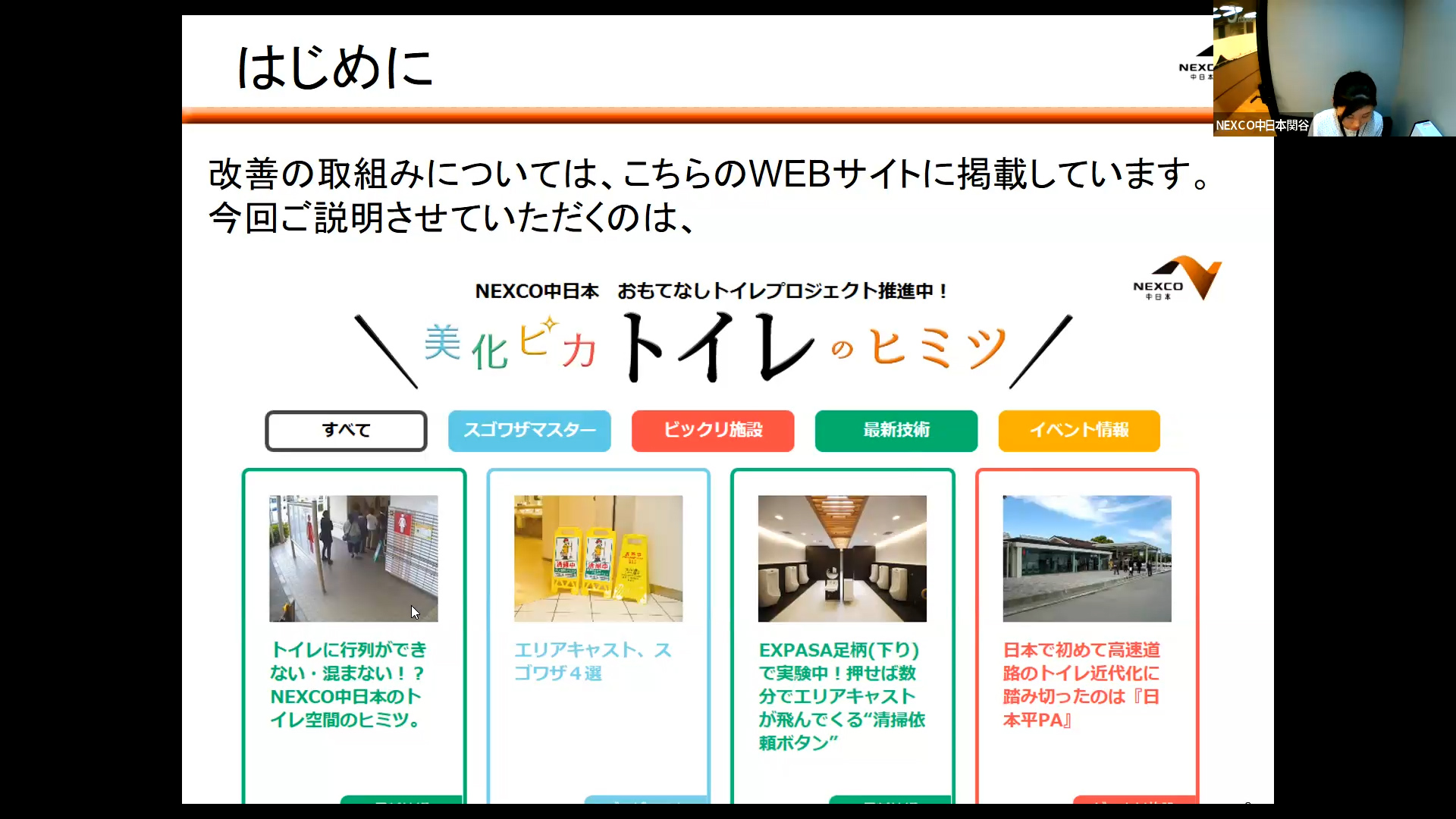 (Sekiya) I am Sekiya and a staff of the Facilities Section of the Maintenance Services Division of Tokyo Branch of Central Nippon Expressway Co., Ltd.
(Sekiya) I am Sekiya and a staff of the Facilities Section of the Maintenance Services Division of Tokyo Branch of Central Nippon Expressway Co., Ltd.
We believe that having a good impression or experience with toilets by the users is an element that leads to a comfortable experience at the expressway. The “Cleaning Request Button” has been in the trial use at Ashigara Service Area (SA) on the outbound lane of the Tomei Expressway between Tokyo and Nagoya since 2013. The button allows users to press when they inform a dirty toilet to the cleaner in real time.
This button was set at the beginning of 2013. However, it only informed to the cleaners that the toilet was dirty, so it was difficult to find out where the dirty one was. Therefore, we improved to make it easier to find the dirty spot in 2018. The toilet areas were grouped into three portions, the cubicle area, the hand washing area, and the corridor area. Then the buttons to inform the cleaners were increased to three.
Along with the improvement of the button, the area classification was also made for the notifications to cleaners who are called “Area Cast” staffs. After receiving a notification to clean, the cleaners can select and register the levels whether the area was dirty, not very dirty, or not dirty at all. The button was also set just above the hand dryers so that users can easily find and push it.
The toilets remained dirty period were reduced by setting it. The number of the notifications from “Cleaning Request Button” increases around noon time when the toilet users increase. The cleaners rushed to the spot but sometimes the toilets were not dirty at all. The interviews to the cleaners revealed that there was higher possibility that someone pressed the button as a prank.
The button has been in trial operation since 2013, and it has been confirmed that it is effective in contributing to beautifying toilets and improving customer satisfaction (CS). However, it was also found that when notified, the effort to find the dirt location by the prank notifications disrupted the cleaning operations.
[Q & A]
(C6-1: Yamamoto) I would like to add that we try our best to keep the toilets as clean as possible. We have found that this button is too novel and causes a lot of mischieves. We are concerned about the future of this button in the company.
(Q6: MU) Are there any way to prevent the mischief?
(Sekiya) When pressing the button, it doesn’t make an alarm but just lights up. There is no significant reaction when pressing it, so there is little resistance to pressing it and may lead to tampering the prank.
We haven’t observed the age group of users who press the button. Even small children could press it as the button is set about 130 cm height from the floor.
(C6-2 Yamamoto) I’ll add a bit more. The button was pressed more on weekdays rather than weekends. It seemed the lorry drivers often pressed it.
(Q7: TA) What about the requests at night? It seems like things are more likely to get dirty at night.
(A7: Yamamoto) According to the log data, no one pressed the button to request to clean at night. It depends on the service area, and some service areas carry out night-time cleaning process.
(Q8: HO) Rather than notifying cleaners about the level of dirt, it may be better to notify them based on the level of urgency, such as requesting them to clean immediately or not so urgent.
(A8: Sekiya) The primary purpose of the survey was to find out how much users would inform the dirt. In that sense, I think we obtained the necessary data for the analysis.
(Q9: HI) Is it included in the category of “not dirty” that one cubicle is informed as dirty but it is used by the next user and cannot be inspected.
(A9: Sekiya) The process is like this: a user informs the toilet is dirty, and a cleaning staff rushes to check. The staff looks for the toilet, measures the level of the dirt, and registers whether it was dirty or not. The users can inform it after use it when they make the toilet dirty.
4. A supermarket project that is easy even the dementia: A unisex toilet for the dementia users
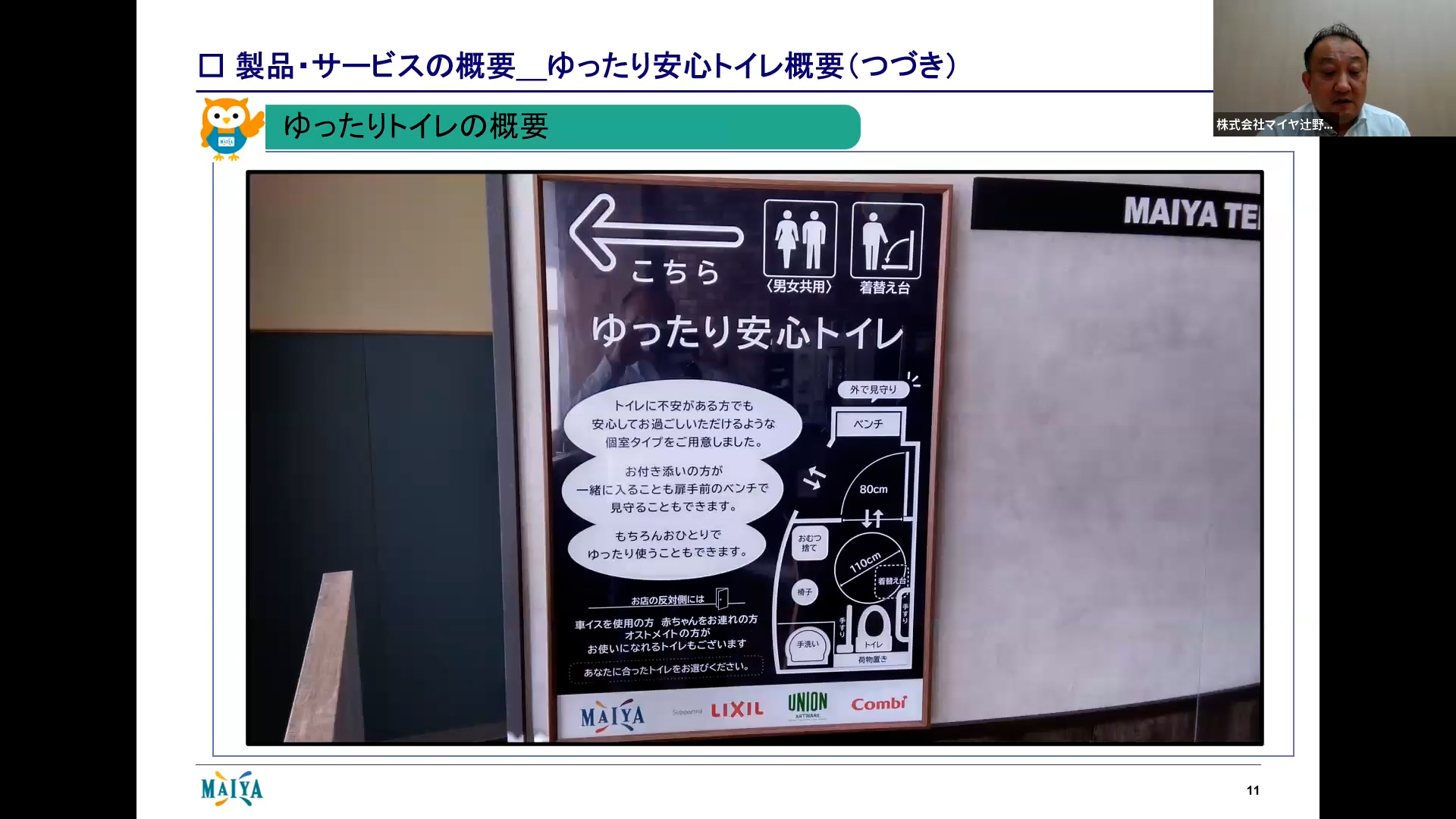 (Tsujino) I am Tsujino of Maiya Co., Ltd. Our company’s head office is in Ofunato, Iwate Prefecture in Japan. Including affiliated companies, there are 20 supermarkets in nine cities and two towns in Iwate and Miyagi prefectures.
(Tsujino) I am Tsujino of Maiya Co., Ltd. Our company’s head office is in Ofunato, Iwate Prefecture in Japan. Including affiliated companies, there are 20 supermarkets in nine cities and two towns in Iwate and Miyagi prefectures.
The “Dementia Friendly Supermarket Project” was started by our company in July 2019, in collaboration with Iwate Northwest Medical Association, Association for People with Dementia and the Families, Takizawa City Comprehensive Community Support Centre, Takizawa City, Social Welfare Council.
The project was started at the suggestion of Dr. Kon-no, a practicing physician in Takizawa city, in order to increase opportunities to go outside and make slow the progression of the dementia. This project has been appointed as a subsidy project by the Ministry of Economy, Trade and Industry for three years starting from 2020.
There are three initiatives: the slow shopping, the partner activities, and the relaxation salon. The users first gather at the relaxation salon and check in. They head off shopping after reporting on their health condition and recent updates.
There are large signs of the store guide on the floor. They can easily find where commodities are without looking up. A map of the store’s layout is also attached to the shopping cart.
During the slow shopping, the participants who wish to be supported are accompanied by a caregiver, family, the social welfare council staff or the medical professionals. The participants in slow shopping are the given priority access to the slow cash register counter where they feel free to take their time for paying. The staffs who have experienced the dementia support training will assist their paying. After shopping, the participants will gather again in the relaxation salon, where they can chat, discuss their concerns about the caregiving, and meet the various people.
We set four accessibility initiatives: the in-store notices, the spacious and safe toilets, the assistance with getting to the store, and adjusting the fine sound and lighting. Maiya Semboku store was scheduled for renovation in April 2022. There was set a spacious and safe toilet during the in-store renovation.
During the renovation, the toilets were located within easy reach from the eat-in area based on the feedback from the people with the dementia, their families, and their caregivers. The entrance was shaped so that it doesn’t look like a toilet, and it was designed to eliminate bad odors. A simple diagram is posted at the entrance of the toilets, introducing the inside layout as the design concept.
A bench chair was set at the outside the toilet for the caregivers can sit on when waiting outside. A large disposable bin was placed inside the toilet so that the adult diapers could be thrown away. A hearing survey was conducted with the participants one year after the renovation. Their common impression was favorable with particularly high evaluation given to its spacious and easy to move around. There were also many positive comments about the total design.
Some participants said it was bright and good about the lighting. While others said it may be somewhat brighter. Some participants pointed that they didn’t mind the toilet is unisex style, while others felt a little awkward it.
There was an opinion that the space was too narrow for the wheelchair users and that they could not use it properly by themselves.
It is estimated that the number of the dementia or at risk of dementia people will be 8 million in Japan by 2035. It is desirable that a dementia friendly society will be realized.
I believe that our corporate philosophy of the contributing to a community-based society will accelerate the corporate value. On the other hand, it is expected for people with the dementia that the opportunities to participate in the economic activities such as shopping, to go out and walk, to alleviate the isolation and increase opportunities for fun and entertainment.
[Q & A]
(Q10: HO) The level of the dementia varies in each patient. Then, how is the solution? Also, regarding the toilets, which level of the dementia patients must focus on?
(A10: Tsujino) We are targeting the participants with the mild dementia level. Also, we have to consider the cost effectiveness on the toilet matters. We plan to proceed by dividing stores into two groups: Some stores are only Slow Shopping and Partner activities, and the other stores that take a comprehensive approach including the toilets.
(C11: KO) I am surprised it will end up being used by many people more than anticipated, when created a comfortable toilet that is easy to use for a wide range of the users including those with caregivers.
(A11: Noguchi) I am involved in this project as a researcher. The people with the dementia can really do more if the supporting system is established for them. The concept at Maiya store was started in the form of the slow shopping. Some other stores made the accessible toilets and then people with the dementia can enjoy shopping just as they could have done before the disease.
The attractive and safe toilet cannot be turned around for the wheelchair users. A toilet for them is prepared the other toilet on the opposite side of the store. This attractive and safe toilet was intended to be used by the dementia people with the caregivers, but now it is used by a wide variety of users. There were included many young people.
I really experienced that if there were the good environment for people with the dementia, the store becomes easy to use for many people.
(Q12: KAW) Regarding the slow shopping, rather than limiting it to certain days and times, I think it would be more symbiotic to set slow cash registers available at any times for the people with the dementia just like for the common customers.
(A12: Tsujino) It is truly ideal that this slow shopping and partner activity can be continued by the four cooperating organizations where each one covers a small amount of the costs and the burden. It is essential that the cash registers where the customers can take their time of paying at any time, and this is not only for people with the dementia. However, there are issues with the costs such as the staff costs, and also problems with the staff shortages. To continue this initiative, we would like to proceed with a small burden on ourselves. Also, as the caregivers are all volunteers, it would be difficult to do it every day.
On the other hand, most of the staffs at this store have finished a dementia supporter training course, so they are ready to help with their shopping at any time.
(C13: Musha) I am involved in this project as a sound expert. I proposed to turn off the background music in the store. Someone with the dementia is overwhelmed with too much information. It may trigger their anxiety and the risk to be panic.
I experienced through the participation in this project that improving the physical environment is very important and combining this with the human support and the operational innovations.
Closing address
(Takahashi) Finally, I would like to hear the comment by Prof. Ueno, who was the head of the judging committee of the last year’s Good Toilet Award.
(Ueno) As we judged and evaluated the applicant works solely based on the submitted materials, and sometimes it must be difficult to appreciate their true intentions. But today, after hearing the applicant speeches, it became much easier to understand.
Now I have confidence that all efforts were at a qualified level for their respective awards. The awards will be called JTA Toilet Awards from this year and we hope many of you will try to apply this award.


